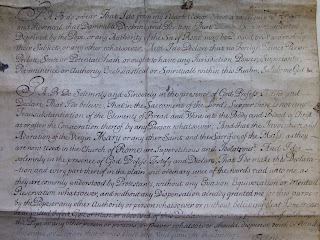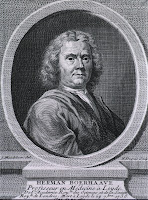Catholics in Irish Medicine. Part I: Exclusion, 1654-1792
Following on from this year's successful Heritage Week Open Day, this is the first in a series of posts which explore some of the themes covered on the day. This first post looks at part of the exhibition on diversity, and the part played by the College in the exclusion of Catholics from Irish medicine during the late seventeenth and eighteenth centuries. To a large extent this exclusion of Catholics was not the aim of the members of the College, but was a result of the political situation and persons in power when key decisions were made.
 |
| RCPI 27 - Dr John Stearne |
In 1654
Dr John Stearne founded the Fraternity of Physicians of Trinity Hall, with the aim of regulating the medical profession and improving standards. Although part of the staunchly Protestant
Trinity College Dublin, in its early years the Fraternity does not seem to have excluded Catholics. In 1667 the Fraternity received its first Royal Charter, which contained no religious discrimination. Perhaps not surprising, as it was granted by
King Charles II, who was secretly considering converting to Catholicism, and was attempting to introduce religious freedom.
The test of the new College's attitude to Catholics came in 1687. As stipulated under the Royal Charter the College had to receive confirmation of their choice of President from Trinity College. In 1687 the College of Physicians proposed Dr John Crosby, a physician who had been a Fellow since 1674. Unusually Trinity refused to confirm the appointment, although they sighted administrative irregularity as the reason, the real cause seems to have been Crosby's Catholicism. Catholic influence in the College of Physicians at this time seems to have been very high, possibly as the result of the flight of many Protestant physicians to England. The College of Physicians decided to cut its links with Trinity, establish itself as an independent organisation and apply for a new Royal Charter.
 |
| RCPI/1/1/2 - Detail from 1692 Royal Charter |
Unfortunately for Catholic medics, this new Charter was not granted until 1692, when the Protestant King William and Queen Mary had replaced the Catholic King James II. This second Royal Charter, which is still largely in force today, was the first to exclude Catholics, a reflection of the strong anti-Catholic feeling in the government at the time. Under the 1692 Charter all Fellows and Officers of the College were required to take the 'oaths, and subscribe to the declarations contained in an Act lately made in the Parliament of England'. This required the taker to deny the supremacy of the Pope, as well as Catholic doctrines including transubstantiation.
 |
| RCPI/5/5/1/1 - Roll of Officers and Fellows, 1692-1790 |
What was not clear in the Charter was whether the College could grant its licences to practice medicine to Catholic medics. The College raised and discussed this question in 1700, and again in 1732, but on neither occasion was a conclusion reached.
 |
| VM/1/2/B/25 - Boerhaave |
With access to medical education at Trinity College, and advancement through the College of Physicians, closed, the only options for those Catholics wishing to study medicine in the eighteenth century were the continental universities. One of the most popular choices was the University of Leiden, where Herman Boerhaave (1668-1738) had revolutionised medical teaching. 122 Irish students attended Leiden during the 30 year period when Boerhaave lectured. Another popular choice for Irish Catholics was Reims University, which saw 542 Irish students between 1620 and 1753. Although the teaching was not considered to be as good as at Leiden, the local religion was Catholic, which was a draw for many. Similarly Montpellier University saw at least 72 Irish students studying medicine during the eighteenth century.